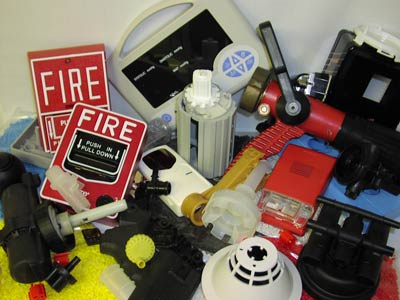Plastic Injection Molding 101: An Overview
Leave a Comment
Plastic injection molding is a complex fabrication process used to create countless products we engage with daily. This includes everything from the keys on your keyboard, buttons on your toaster, or gears grinding away under your car’s hood. Plastic injection molded parts are everywhere. Today, we’ll take a closer look at injection molding, the process, and its advantages.
What is Plastic Injection Molding?
Plastic injection molding starts with a mold that contains impressions of the part or assembly that is being fabricated. The mold is then injected with melted plastic, which takes the shape of the mold, and cools down to create the solid component.
The process has been around since the early 1870’s (or late 1860’s or even earlier depending on who you ask) when the earliest molding machines were made and patented. Back then, injection molding was used to make common items such as combs, buttons, and other small parts.
The Injection Molding Process
- Design – the process begins with part design, which includes material selection and part prototyping.

- Die/Mold/Tool Making – once designs and prototypes are approved, production dies are made. For high-run jobs, multi-cavity molds may be used to produce multiple parts at once. This brings efficiency by cutting down run time, which reduces part cost. Intricate parts and assemblies may require more advanced tooling in addition to complex molds, such as jigs and other work holding and processing solutions.
- Material Introduction – raw plastic material, typically in the form of pellets or granules, is fed into a hopper. This material can be conventional plastic, or engineering resins for more demanding uses. These include glass-filled, carbon-filled, PTFE (Teflon) filled Thermoplastics. This all depends on the functional, operational, and aesthetic requirements of the parts being molded.
- Melting – the plastic moves into a heated barrel where it melts and mixes uniformly.
- Injection – the molten plastic is then pushed into a closed mold cavity at high pressure, ensuring it is completely filled.
- Cooling – the plastic then cools and solidifies into the desired shape.
- Ejection – the mold opens, and the cooled finished part is pushed out by ejector pins.
- Inspection – certain plastic molding suppliers, such as PDI,
 will utilize inline part inspection to help ensure part quality. With this critical step, an image of the finished part is taken, compared to a reference image, and is either accepted, or, sadly, pushed into the reject bin. (But don’t be too sad, that part will get a second chance here at PDI, since we recycle all excess plastic inline!)
will utilize inline part inspection to help ensure part quality. With this critical step, an image of the finished part is taken, compared to a reference image, and is either accepted, or, sadly, pushed into the reject bin. (But don’t be too sad, that part will get a second chance here at PDI, since we recycle all excess plastic inline!) - Assembly (if required) – more complex components or assemblies will go through further automated or manual steps for assembly or packaging.
- Repeat – the plastic injection molding cycle then restarts, ready to produce the next batch of parts, until the order is ready to ship.
Why Choose Plastics for your Component or Assembly?
Plastic injection molding, and the materials used, offer many properties making it ideal for part fabrication:

- Versatility – plastics come in a wide range of types allowing you to tailor material selection to your specific requirements. Specific properties include strength, flexibility, heat resistance, corrosion, and chemical resistance.
- Durability – thermoplastics, or engineering resins, in particular can withstand significant wear and tear, making them suitable for long-lasting parts. Properties for certain materials are comparable to metals.
- Lightweight – when matched up against metals, thermoplastics offer significant weight reduction, critical for weight-sensitive applications like aerospace and automotive.
- Cost-Effective – injection molding allows for high-volume production at a relatively low cost per part.
- Design Flexibility – the process allows engineers and product designers to create complex shapes with intricate details, allowing for innovative product design.
The Future of Plastic Injection Molding
Molding has come a very long way in a century and a half. Time and technology have been good friends to the process. It went from a rather basic, manually driven production method with few material selections, to one that can be fully automated, with an extensive menu of materials available. As technology continues to advance, injection molding will continue to evolve. We can expect to see:
- More Sustainable Materials – biodegradable and recyclable plastics are gaining traction for a more eco-friendly future.
- Multi-shot Molding – fabricating parts with multiple materials and functionalities within a single mold, rather than high quantities of the same exact part at once.
- Continued Advancement in Automation and Monitoring – Increased automation and real-time process monitoring for enhanced efficiency and quality control.
Plastic injection molding is an indispensable and flexible manufacturing process that has stood the test of time. It is used in practically every industry today to produce simple to intricate parts that range in size, complexity, material, and use. Leveraging the many benefits of injection molding can help manufacturers increase efficiency and product evolution, thus making manufacturers more competitive and profitable.
Want to see if Plastic Injection Molding is right for your part fabrication needs? Contact us today, we’re happy to see if we can help reduce current part cost, or produce new ones.
